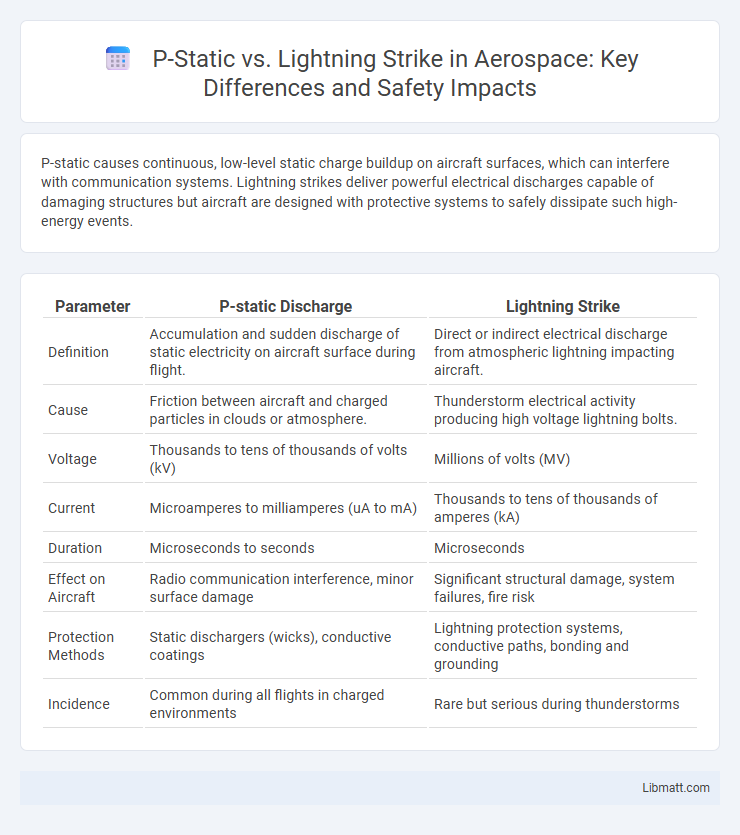P-static causes continuous, low-level static charge buildup on aircraft surfaces, which can interfere with communication systems. Lightning strikes deliver powerful electrical discharges capable of damaging structures but aircraft are designed with protective systems to safely dissipate such high-energy events.
Table of Comparison
| Parameter | P-static Discharge | Lightning Strike |
|---|---|---|
| Definition | Accumulation and sudden discharge of static electricity on aircraft surface during flight. | Direct or indirect electrical discharge from atmospheric lightning impacting aircraft. |
| Cause | Friction between aircraft and charged particles in clouds or atmosphere. | Thunderstorm electrical activity producing high voltage lightning bolts. |
| Voltage | Thousands to tens of thousands of volts (kV) | Millions of volts (MV) |
| Current | Microamperes to milliamperes (uA to mA) | Thousands to tens of thousands of amperes (kA) |
| Duration | Microseconds to seconds | Microseconds |
| Effect on Aircraft | Radio communication interference, minor surface damage | Significant structural damage, system failures, fire risk |
| Protection Methods | Static dischargers (wicks), conductive coatings | Lightning protection systems, conductive paths, bonding and grounding |
| Incidence | Common during all flights in charged environments | Rare but serious during thunderstorms |
Introduction to P-static and Lightning Strikes
P-static refers to the buildup of electrical charge on an aircraft's surface caused by friction with air particles, which can lead to radio interference and potential equipment malfunctions. Lightning strikes are intense electrical discharges that occur when a charged storm cloud connects with an aircraft, posing significant safety risks such as structural damage or system failures. Understanding these phenomena is crucial for maintaining your aircraft's operational integrity and ensuring flight safety.
Defining P-static: Causes and Effects
P-static, or precipitation static, occurs when friction between airborne particles such as rain, snow, or dust and an aircraft's surface generates electrical charges, leading to static buildup. This static discharge can interfere with onboard avionics and communication systems, causing noise and signal disruption. Understanding the causes of P-static helps you mitigate its effects, which differ significantly from a lightning strike's more intense and potentially catastrophic electrical discharge.
Understanding Lightning Strikes in Aviation
Lightning strikes in aviation occur when an aircraft becomes part of an electrical circuit during a storm, accumulating static electricity that discharges rapidly. P-static, or precipitation static, is a different phenomenon where static buildup from raindrops, snow, or ice causes radio interference and minor shocks, unlike lightning which involves massive electrical energy. Understanding these differences helps you ensure better aircraft safety procedures and effective lightning strike prevention measures.
Key Differences Between P-static and Lightning Strikes
P-static and lightning strikes differ primarily in their scale and impact; P-static involves the buildup of static electricity on aircraft surfaces causing minor interference, whereas lightning strikes are powerful electrical discharges that can cause significant structural damage. P-static typically affects radio communications and navigation systems due to accumulated charges, while lightning strikes pose direct hazards including burns, structural damage, and electrical failure. Understanding these distinctions helps you implement appropriate safety measures and maintain operational integrity in aviation environments.
Detection Methods for P-static and Lightning
P-static detection primarily relies on electrostatic field sensors and antennas that monitor charged particle accumulation on aircraft surfaces, enabling early identification of static discharge risks. Lightning detection utilizes advanced optical sensors, such as photomultiplier tubes and high-speed cameras, alongside electromagnetic field detectors that capture the distinct electrical signatures and RF emissions produced during a strike. Both detection methods integrate real-time data processing systems within avionics to enhance situational awareness and ensure timely response to atmospheric electrical phenomena.
Impacts on Aircraft Systems and Avionics
P-static causes surface noise and interference in aircraft communication and navigation systems, often resulting in static discharge that can disrupt radio signals and avionics performance. Lightning strikes pose a far greater threat by inducing high-voltage surges that can damage electrical components, avionics hardware, and flight control systems, potentially leading to critical system failures. Both phenomena require robust shielding and grounding measures to protect sensitive aircraft electronics and maintain operational integrity during flight.
Protective Measures Against P-static
Protective measures against P-static include installing static dissipative materials and grounding systems to prevent charge accumulation on aircraft surfaces. Using conductive coatings and static wicks helps to safely discharge static electricity during flight, minimizing interference with onboard electronics. Your aircraft's maintenance routine should incorporate regular inspections of these components to ensure optimal P-static protection.
Lightning Protection Technologies in Aviation
Lightning protection technologies in aviation incorporate advanced materials like conductive composites and metallic meshes to dissipate lightning strike energy and prevent structural damage. Aircraft designs employ bonding and grounding systems to maintain electrical continuity, ensuring safe current flow and minimizing the risk of P-static discharge that can interfere with avionics. Your safety relies on these integrated innovations, which effectively manage both lightning strikes and static electricity buildup during flight.
Regulatory Standards for Electromagnetic Events
Regulatory standards such as IEC 61000-4-2 for electrostatic discharge (P-static) and IEC 62305 for lightning protection outline specific performance criteria and testing procedures to ensure equipment resilience against electromagnetic events. These standards define thresholds for voltage, current, and duration, guiding the design of protection systems to mitigate damage from static discharge and direct lightning strikes. Compliance with these regulations is critical for industries like aerospace and telecommunications to maintain operational safety and electromagnetic compatibility.
Summary: Choosing the Right Protection Approach
P-static represents low-energy static electricity discharges typically managed with grounding and dissipation methods, while lightning strikes involve high-energy, destructive currents requiring robust surge protection devices and grounding systems. Selecting the right protection approach depends on risk assessment, environmental conditions, and equipment susceptibility, balancing static discharge mitigation with comprehensive lightning strike defense. Implementing integrated protection ensures operational safety and minimizes damage in aerospace, aviation, and high-voltage infrastructure applications.
P-static vs Lightning strike Infographic

 libmatt.com
libmatt.com